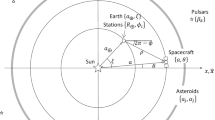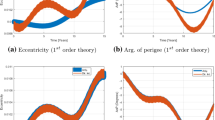Abstract
An algorithm is presented for solving the lost-in-space problem using simultaneous observations of X-ray pulsars. Using a norm-minimization-based approach, the algorithm extends a previous banded-error intersection model to 3-dimensional space. Higher-fidelity X-ray pulsar signal models are considered, including the parallax effect, Shapiro delay, time dilation, and higher-order pulsar frequency models. The feasibility of solving the lost-in-space problem using X-ray pulsar navigation is revisited with the improved models and prior knowledge requirements are discussed. Monte Carlo simulation techniques are used to establish upper bounds on uncertainty and determine the accuracy of the algorithm. Results indicate that it is necessary to account for the parallax effect, time dilation, and higher-order pulsar frequency models in order to successfully determine the position of the spacecraft in a lost-in-space scenario. In a heliocentric case study, the algorithm uniquely identified a candidate spacecraft position within a spheroid search domain up to 10\(\times\)10\(\times\)0.01 AU\(^3\) in size by simultaneously observing eight to nine pulsars. The maximum search domain size can be increased by observing additional pulsars, which may allow the lost-in-space problem to be solved anywhere within the Solar System. The median position error of the algorithm is on the order of 15 km. Results further indicate that choosing lower-frequency pulsars increases the maximum search domain size at the expense of increased position error.


















Similar content being viewed by others
References
Allan, D.: Millisecond pulsar rivals best atomic clock stability. In: 41st Annual Symposium on Frequency Control, pp. 2–11 (1987). https://doi.org/10.1109/freq.1987.200994. IEEE
Winternitz, L.M., Hassouneh, M.A., Mitchell, J.W., Valdez, J.E., Price, S.R., Semper, S.R., Wayne, H.Y., Ray, P.S., Wood, K.S., Arzoumanian, Z., et al.: X-ray pulsar navigation algorithms and testbed for sextant. In: 2015 IEEE Aerospace Conference, pp. 1–14 (2015). https://doi.org/10.1109/AERO.2015.7118936. IEEE
Graven, P., Collins, J., Sheikh, S., Hanson, J., Ray, P., Wood, K.: Xnav for deep space navigation. In: 31st Annual AAS Guidance and Control Conference (2008). AAS San Diego. AAS 08-054. https://www.asterlabs.com/publications/2008/Graven_et_al,_AAS_31_GCC_February_2008.pdf
Winternitz, L.M., Mitchell, J.W., Hassouneh, M.A., Valdez, J.E., Price, S.R., Semper, S.R., Wayne, H.Y., Ray, P.S., Wood, K.S., Arzoumanian, Z., et al.: Sextant x-ray pulsar navigation demonstration: Flight system and test results. In: 2016 IEEE Aerospace Conference (2016). https://doi.org/10.1109/AERO.2016.7500838. IEEE
Tanygin, S.: Closed-form solution for lost-in-space visual navigation problem. J. Guid. Control Dyn. 37(6), 1754–1766 (2014). https://doi.org/10.2514/1.G000529
Adams, V.H., Peck, M.A.: Lost in space and time. In: AIAA Guidance, Navigation, and Control Conference, p. 1030 (2017). https://doi.org/10.2514/6.2017-1030
Dahir, A.R.: Lost in space: Autonomous deep space navigation. PhD thesis, University of Colorado at Boulder (2020). https://www.proquest.com/dissertations-theses/lost-space-autonomous-deep-navigation/docview/2408808776/se-2
Hollenberg, C.L., Christian, J.A.: Geometric solutions for problems in velocity-based orbit determination. J. Astronaut. Sci. 67(1), 188–224 (2020). https://doi.org/10.1007/s40295-019-00170-7
Hou, L., Lohan, K., Putnam, Z.R.: Comparison and error modeling of velocity-based initial orbit determination algorithms. In: AAS/AIAA Space Flight Mechanics Meeting, Virtual (2021). AAS 21-280
Sala Álvarez, J., Urruela Planas, A., Villares Piera, N.J., Estalella, R., Paredes, J.M.: Feasibility study for a spacecraft navigation system relying on pulsar timing information. Technical report, ESA Ariadna Study (2004). http://hdl.handle.net/2117/11514
Sheikh, S.I.: The use of variable celestial x-ray sources for spacecraft navigation. PhD thesis, University of Maryland (2005). https://drum.lib.umd.edu/handle/1903/2856 Accessed 2021-10-11
Golshan, A.R., Sheikh, S.I.: On pulse phase estimation and tracking of variable celestial x-ray sources. In: Proceedings of the 63rd Annual Meeting of The Institute of Navigation (2007), Cambridge, MA, pp. 413–422. https://www.asterlabs.com/publications/2007/Golshan_ &_Sheikh,_ION_63_AM_April_2007.pdf
Anderson, K.D.: Phase tracking methods for x-ray pulsar-based spacecraft navigation. PhD thesis, University of Maryland (2021). https://doi.org/10.13016/zg56-nipg
Sheikh, S.I., Golshan, A.R., Pines, D.J.: Absolute and relative position determination using variable celestial x-ray sources. In: 30th Annual AAS Guidance and Control Conference, pp. 855–874 (2007). American Astronautical Society Breckenridge, Colorado. https://www.asterlabs.com/publications/2007/Sheikh_Golshan_ &_Pines,_AAS_GCC_February_2007.pdf
Huang, L., Lin, Q., Zhang, X., Shuai, P.: Fast ambiguity resolution for pulsar-based navigation by means of hypothesis testing. IEEE Trans. Aerosp. Electron. Syst. 53(1), 137–147 (2017). https://doi.org/10.1109/TAES.2017.2649698
Lohan, K.: Methodology for state determination without prior information using x-ray pulsar navigation systems. PhD thesis, University of Illinois at Urbana-Champaign (2021). https://hdl.handle.net/2142/113068
Sheikh, S.I., Hellings, R.W., Matzner, R.A.: High-order pulsar timing for navigation. In: Proceedings of the 63rd Annual Meeting of The Institute of Navigation, pp. 432–443 (2007). https://www.asterlabs.com/publications/2007/Sheikh_Hellings_Matzner,_ION_63_AM_April_2007.pdf
Huygens, C.: Oeuvres Complètes de Christiaan Huygens vol. 8. Martinus Nijhoff, The Hague (1899). https://doi.org/10.5962/bhl.title.21031
Edwards, R.T., Hobbs, G., Manchester, R.: Tempo2, a new pulsar timing package - ii. The timing model and precision estimates. Mon. Notices R. Astron. Soc. 372(4), 1549–1574 (2006). https://doi.org/10.1111/j.1365-2966.2006.10870.x
Backer, D., Hellings, R.: Pulsar timing and general relativity. Ann. Rev. Astron. Astrophys. 24(1), 537–575 (1986). https://doi.org/10.1146/annurev.aa.24.090186.002541
Desvignes, G., Caballero, R., Lentati, L., Verbiest, J., Champion, D., Stappers, B., Janssen, G., Lazarus, P., Osłowski, S., Babak, S., et al.: High-precision timing of 42 millisecond pulsars with the European pulsar timing array. Mon. Notices R. Astron. Soc. 458(3), 3341–3380 (2016). https://doi.org/10.1093/mnras/stw483
Freire, P.C., Wex, N., Esposito-Farèse, G., Verbiest, J.P., Bailes, M., Jacoby, B.A., Kramer, M., Stairs, I.H., Antoniadis, J., Janssen, G.H.: The relativistic pulsar-white dwarf binary psr j1738+ 0333–ii. The most stringent test of scalar-tensor gravity. Mon. Notices R. Astron. Soc. 423(4), 3328–3343 (2012). https://doi.org/10.1111/j.1365-2966.2012.21253.x
Hobbs, G., Manchester, R., Teoh, A., Hobbs, M.: The ATNF pulsar catalog. In: Symposium-International Astronomical Union, vol. 218, pp. 139–140 (2004). https://doi.org/10.1017/s0074180900180829. Cambridge University Press
Thomas, J.: Reformulation of the relativistic conversion between coordinate time and atomic time. Astron. J. 80, 405–411 (1975). https://doi.org/10.1086/111756
Moyer, T.D.: Transformation from proper time on earth to coordinate time in solar system barycentric space-time frame of reference. Celest. Mech. 23(1), 33–56 (1981). https://doi.org/10.1007/BF01228543
Lohan, K., Putnam, Z.: Characterization of candidate solutions for x-ray pulsar navigation. IEEE Trans. Aerosp. Electron. Syst. (2022). https://doi.org/10.1109/TAES.2022.3152684
An Overview of Reference Frame and Coordinate Systems in the SPICE Context. https://naif.jpl.nasa.gov/pub/naif/toolkit_docs/Tutorials/pdf/individual_docs/17_frames_and_coordinate_systems.pdf. Accessed: 2022-03-30
The ABC of XTE | A Time Tutorial. https://heasarc.gsfc.nasa.gov/docs/xte/abc/time_tutorial.html. Accessed 30 Mar 2022
NASA: General Mission Analysis Tool (GMAT). Version R2020a. https://sourceforge.net/projects/gmat/
Anderson, K.D., Pines, D., Sheikh, S.: Investigation of x-ray pulsar signal phase tracking for spacecraft navigation. In: AIAA SCITECH 2022 Forum, p. 1589 (2022). https://doi.org/10.2514/6.2022-1589
Visualize summary statistics with box plot - MATLAB boxplot. https://www.mathworks.com/help/stats/boxplot.html. Accessed 12 Jun 2022
Shemar, S., Fraser, G., Heil, L., Hindley, D., Martindale, A., Molyneux, P., Pye, J., Warwick, R., Lamb, A.: Towards practical autonomous deep-space navigation using x-ray pulsar timing. Exp. Astron. 42(2), 101–138 (2016). https://doi.org/10.1007/s10686-016-9496-z
Mitchell, J.W., Winternitz, L.M., Hassouneh, M.A., Price, S.R., Semper, S.R., Yu, W.H., Ray, P.S., Wolff, M.T., Kerr, M., Wood, K.S., et al.: Sextant x-ray pulsar navigation demonstration: Initial on-orbit results. In: Annual American Astronautical Society (AAS) Guidance and Control Conference 2018 (2018). https://ntrs.nasa.gov/api/citations/20180001252/downloads/20180001252.pdf
Ray, P.S., Wood, K.S., Wolff, M.T.: Characterization of pulsar sources for x-ray navigation. arXiv preprint arXiv:1711.08507 (2017). https://doi.org/10.48550/arXiv.1711.08507
Sun, H., Sun, X., Fang, H., Shen, L., Cong, S., Liu, Y., Li, X., Bao, W.: Building x-ray pulsar timing model without the use of radio parameters. Acta Astronaut. 143, 155–162 (2018). https://doi.org/10.1016/j.actaastro.2017.11.014
Sheikh, S.I., Pines, D.J., Ray, P.S., Wood, K.S., Lovellette, M.N., Wolff, M.T.: Spacecraft navigation using x-ray pulsars. J. Guid. Control Dyn. 29(1), 49–63 (2006). https://doi.org/10.2514/1.13331
Author information
Authors and Affiliations
Corresponding author
Ethics declarations
Conflict of interest
The authors declare no conflicts of interest.
Additional information
Publisher's Note
Springer Nature remains neutral with regard to jurisdictional claims in published maps and institutional affiliations.
Rights and permissions
Springer Nature or its licensor (e.g. a society or other partner) holds exclusive rights to this article under a publishing agreement with the author(s) or other rightsholder(s); author self-archiving of the accepted manuscript version of this article is solely governed by the terms of such publishing agreement and applicable law.
About this article
Cite this article
Hou, L., Putnam, Z.R. A Norm-Minimization Algorithm for Solving the Lost-in-Space Problem with XNAV. J Astronaut Sci 71, 6 (2024). https://doi.org/10.1007/s40295-023-00425-4
Accepted:
Published:
DOI: https://doi.org/10.1007/s40295-023-00425-4




